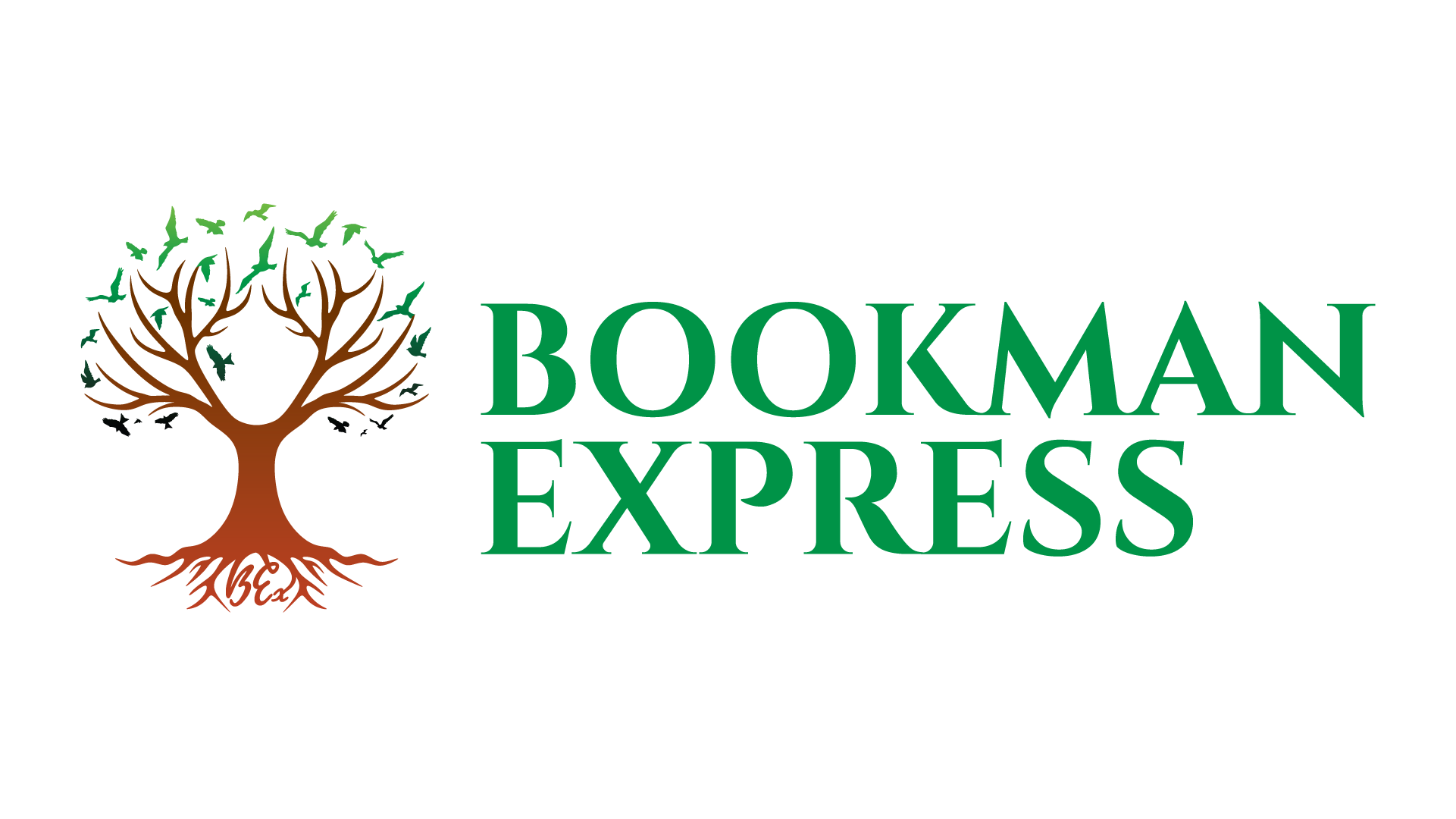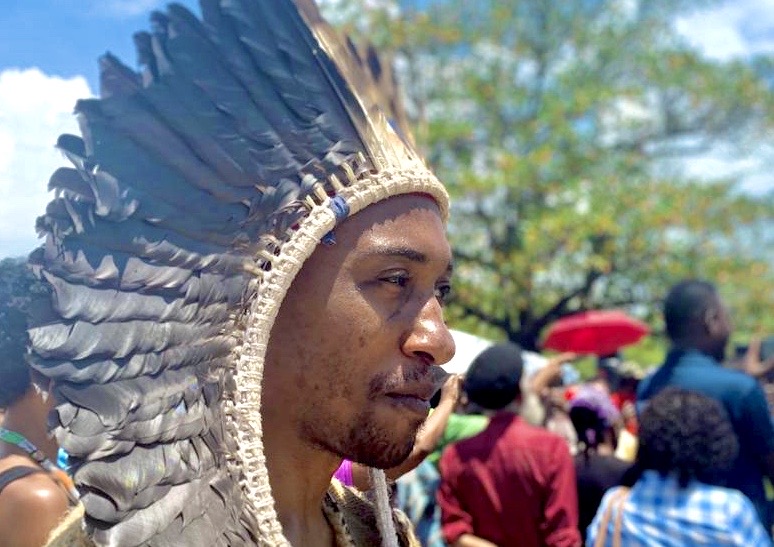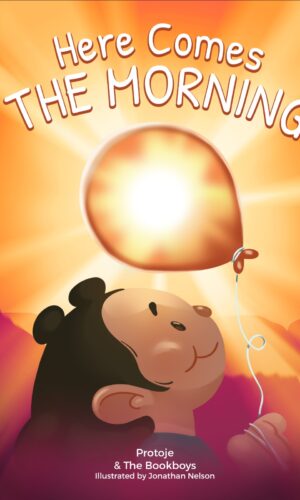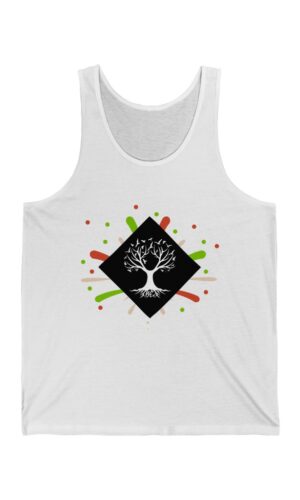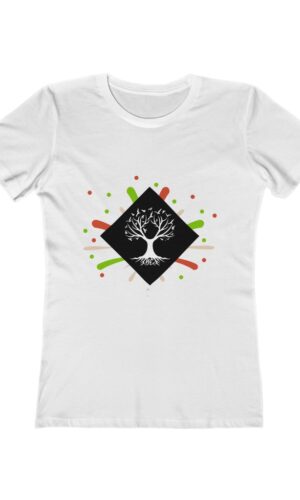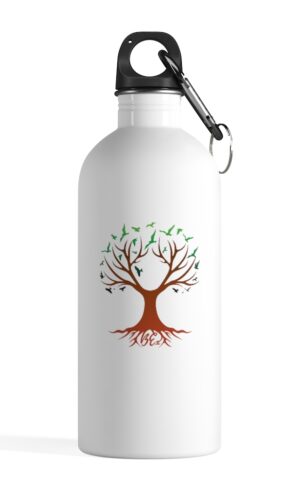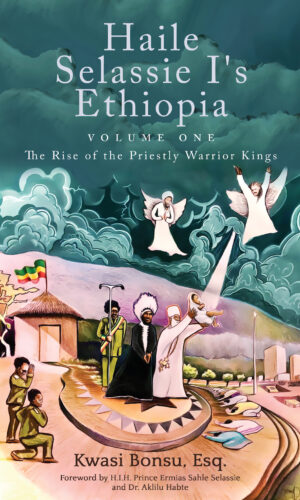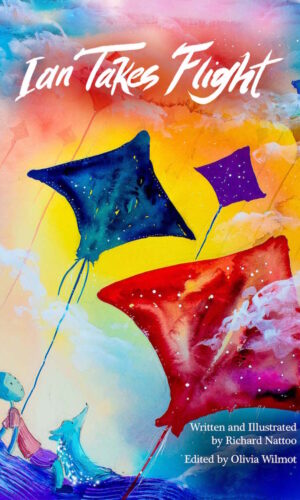The English-speaking Caribbean celebrates Emancipation Day annually on the first day of August, commemorating that date in 1834 when the British Empire’s Slave Abolition Act began to take effect. As we proudly celebrate the efforts of our African ancestors who struggled incessantly to make our present liberties possible, we also turn our minds to another group of people whose continued presence and contributions in the region have been ignored or, at best, glossed over: the Indigenous people. With a Taino resurgence happening in Jamaica, we reached out to Kasike ‘Kalaan’ Nibonrix Kaiman for crucial education about his tribe’s history, culture and worldview, as well as the deliberate erasure of their identity throughout centuries of colonization and neo-colonization.
How is the term Indigenous best defined?
I have become quite fond of the definition used by the United Nations: “Indigenous peoples are inheritors and practitioners of unique cultures and ways of relating to people and the environment. They have retained social, cultural, economic and political characteristics that are distinct from those of the dominant societies in which they live.”
Which particular people do you represent?
I am the Medicine Man and Chief of Yukayeke Yamaye Guani – the Jamaican Hummingbird Tribe. We acknowledge that our ancestors are identified as Yamaye, the people of Yamayeka, known today as Jamaica. Our ancestors did not identify as Taino but we have accepted it as an umbrella term for a specific group of Indigenous people in the Caribbean.
How did the word Taino come about?
Taino really translates as “relatives” and is more a contemporary academic classifier. A researcher decided to use the term based on an entry in Christopher Columbus’ journal from his second voyage. We know he brought Natives back to Spain from the previous trip, so it’s safe to assume he brought them with him on his second voyage, after they had learned some Spanish. In Guadeloupe, when the people on the land saw them on his ship, they ran out saying, Taino! Taino! It was assumed that it was a tribal identifier but the root word is Nita, which means “my blood,” and No is a plural suffix for “people.” So they were really saying, Blood people! Relatives! But, again, the academics took it as the people identifying themselves as Taino, and they started to use it as an identifier in the wider Caribbean. There was a common trading language throughout the region so it might have seemed like the different tribes of the islands were not distinct from each other.
Why are so many people unaware that Tainos still exist?
It has been taught that Tainos are extinct. The education systems didn’t teach cultural assimilation. They didn’t teach that we intertwined, had relations and had alliances with the Africans, with the Maroons, with the Europeans. The teaching in schools is that we’re extinct. When I was at school, they called our ancestors Arawaks, probably because the Indigenous people of the Caribbean spoke an Arawakan language. The Arawak people are located in and around the Orinoco Basin of South America, and it was assumed by academics that these were the same people who were in the Caribbean. Later on, they realized it was a different people and tried to shift the terminology to Island Arawak but it became confusing and didn’t catch on.
The erasure of Indigenous identity and people in Jamaica happened in three stages. The first stage, during the Spanish occupation from the 15th to the 17th century, involved absorbing the Indigenous community. The colonizers’ idea was for Natives to be subservient and work for them. They didn’t want to get rid of them but wanted them to feel comfortable to a degree. So, a lot of what happened was syncretism between their spiritualities, where they could practice their Indigenous ways but use the names of certain Catholic saints, for instance. The second stage of erasure involving the British was a little different. By the time the British came into the picture, they observed a Native population resistant to subjugation and they considered two options. One, either trick the people and make them live in some undesirable spaces, like a swamp area, or two try to get rid of them and blame it on the Spanish, which is what they did. So the British ended up saying that there were less Tainos in Jamaica than there actually were. The third stage happened after independence in 1962. It was problematic to have the existence of people with a strong birthright to this land, so the education system was used to teach that they were extinct. That was a form of paper genocide in Jamaica, and it has been shown that the government knew otherwise. There were minority reports showing a small percentage of Indigenous people. Most of the fishing villages of today were originally Indigenous communities.
How is this long held, false extinction narrative being combatted?
In this resurgence, with the advent of a lot of critical thinking and revisiting his story, we come to the awareness that clearly our people were not extinct. When Jamaica was a colony of Spain, for example, a Catholic church had a baptism record which included 74 Tainos up to the year 1611. This obviously doesn’t account for all the Native people, especially since the Spanish didn’t populate the entire island. They weren’t in the mountainous regions where many of our people lived. The oral history of the Maroons and artifacts archaeologically found in Old Nanny Town confirm that Tainos and what we now refer to as Maroons coexisted. Why I say what we now refer to as Maroons is because the original Maroons were the Tainos. In other words, they were the first wave of people who fled to the mountains while the Spanish were here. To be clear, Yamaye were the first Maroons but not all Yamaye were Maroons. Some assimilated and were enslaved.
When the Spanish saw that the British were coming upon them, they freed the slaves and those slaves also went to the mountain along with some of the first Black people who came to Jamaica. They were some of the first individuals to run up into the mountains, even though they were trained in guerilla warfare and had the option to fight for the Spanish. Then, mainland Africans first started appearing in large numbers with the British. Records show that ones from among the Coromantee people broke loose as soon as they touched land and found their way up to the mountains. They were probably the largest wave of Maroons. So, a lot of the details that make up the story of our island was taken from us. I mean the information is there but it was not shared. The English took over in 1655 and our coat of arms, established in 1661, originally said, The two Indians will serve as one. Now, if they were extinct when they were making the coat of arms and motto, what two Indians were they referring to and what would they be serving? So, there are things in plain sight that speak towards the ludicrousness of the extinction narrative.
How have centuries of colonization and exposure to other peoples affected the cultural traditions of Tainos?
All Taino today are a mixture of European, African, and Native American. The same can be said for all Caribbean people as it relates to cultural heritage. Each wave of occupation of the islands, starting from the Native American, has influenced our practice of relating to the environment around us and has given us the opportunity to take advantage of the best of each culture. Sadly, most people not centered in that awareness follow the trends of dominant society, which is centered in a mentality of lack and competitiveness, which results in hoarding and inequality.
How has your upbringing prepared you to lead Taino resurgence in Jamaica?
Growing up, I’ve always had a connection to things indigenous. Native ancestral ways. Ancestral ways of the Americas more than the ancestral ways of anywhere else. The confirmations that I’ve had about this have been too much to ignore. I’m a descendant of Maroons and Tainos. My great grandfather identified as a Maroon Coolie, which was a term that was used previously for Maroons that had Taino ancestry, connection or bloodline. Interestingly enough, I cannot confirm if his Taino ancestry is from Jamaica or from Cuba. His mother was from Cuba and it was reported that she spoke a language that was not Spanish. I must mention that in my family and throughout a portion of our history in Jamaica, the word Maroon came with certain negative connotations. Maroons were seen as traitors, so I didn’t learn about that part of my family until I was a lot older. My grandmother would tell my great grandfather that he’s not to tell anyone that he’s a Maroon Coolie. Since I’ve gotten more involved with the Maroon and Taino communities, my grandmother would look at me like whoa, you know? She wished she had learned more about her father’s side of the family from him. Her mindset was what she was taught. Everyone in Jamaica knows about the European ancestors, who’s Scottish, who’s Irish and so on, but we don’t know about our Indigenous ancestry. We don’t know much about our African ancestry. So we don’t really have much roots and I see the effect of that all around.
We’re out of touch with cycles of nature, with the sun, with the moon. So the systems that exist are far from our ancestral systems and the result is what we’re seeing today with a lot of crime and violence.
What effects of the lack of Indigenous and African ancestral knowledge do you notice?
It is the health issues that we have, physical, mental and spiritual. If there is an ailment, the young ones today want to Google it and the majority of the references they will find, to be honest, is really catered towards caucasians. The images and a lot of the ailments that come from those symptoms are not really for people of color. The reality is that everything is not one size fits all. A lot of health issues come from consuming food that is not our food, not the right nourishments that we require.
We’ve adopted this sense of entertainment with everything. We read for entertainment, we eat for entertainment, we drink for entertainment, and we’ve lost our understanding of the cycles of life and balance. I’m not saying anything is wrong with entertainment but, at the same time, you can’t be entertaining things when your health has been declining so drastically.
Another effect is the competitive nature of our education system, where it is valued that one person is at the top and one person is last. Traditionally, our community is one of working together, so all in a particular age group would ensure that everybody is working together. They would be sharing and bonding. We’re out of touch with cycles of nature, with the sun, with the moon. So the systems that exist are far from our ancestral systems and the result is what we’re seeing today with a lot of crime and violence. It’s so much that is going on today. Men are abusing women and young children. All of this stems from the fact that they are lost. When you’re lost and struggling, it’s like someone who can’t swim out at sea. The first person they grab, dem probably going try carry dem down with them, other than thinking that both of them can survive together.
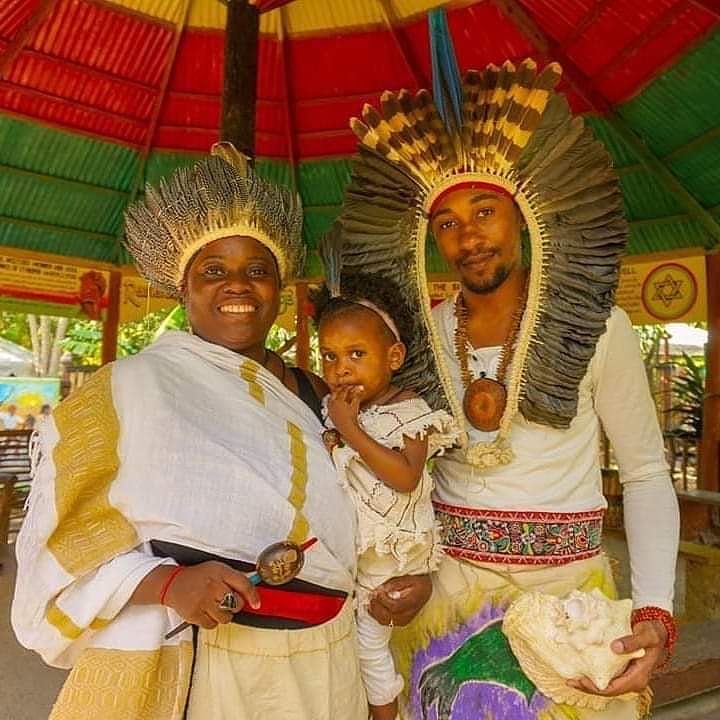
Kasike stands with his wife Ronalda “Kaikotekina” and daughter Tanama. [Contributed]
How are Taino cultural practices being passed on at this time?
There’s a lot being done and a lot to be done. We’re working on bringing back our pottery, bringing back our ceremonies, bringing back our regalia, our dress, bringing back our language. Throughout the community there are groups working on these things. At some points in time you find that we have two Taino languages because of variations in dialect, and some groups stick to some schools of thought more than others but I am very happy and proud to say we’re making a lot of advancement, and the next generation will have a lot more information. My beautiful daughter and my beautiful wife are also a part of this movement. My wife has Maroon ancestry, and my daughter was born with what some call an indigo spot or a Mongolian spot. That’s another confirmation of that Native ancestry and that Native bloodline being passed on.
How interconnected are Tainos in the Caribbean and also with the wider Indigenous peoples of the Americas?
Now, what is going on currently in the community is people of Borinquen (Puerto Rico), people of Quisqueya (Dominican Republic), people of Cuba, people of Yamayeka, we are actively reclaiming our Indigenous heritage. We are actively working towards protecting our sacred sites and I would like to take this opportunity to draw attention to the hashtag #protectsacredsites. For instance, there has been some issue with the sacred site in Jayuya and this is an ancient Taino site, a Batey, a ceremonial space, and, it was being attacked – I don’t have any other way to put it. They wanted to clear the land for farming and though it seems like things have settled for now, until something is done by the government, or on paper, to protect this site, there’s the possibility of this happening again. So, these are the things that we face in the Caribbean Diaspora and also the States. There are a lot of battles out there and we support our other Indigenous relatives throughout Abdialala, throughout the Americas, north, central and south. So, we’re always present at rallies, at marches. There are Tainos at Standing Rock. There are actually several Yukayekes – our term for Tribes – in the States. There are even Taino awards held there to honor those who are active in the community. There’s an awareness of Taino identity and we have a strong presence in Indigenous groups. There’s an awareness of us. Natives from the Colombian Cofán Tribe have come to the island and have done ceremony with me. We push to bring our people together, to usher in a time of peace.
Are there any major events or gatherings for Indigenous people of the hemisphere?
One activity that helps to unite and bring awareness comes from when they wanted to celebrate five hundred years of Columbus’ “discovery” in 1992. The Indigenous people decided that we needed to do something to show that we’re still here, so they gathered in ceremony at Quito, Ecuador. People from the north, from the south, all over, around the sacred fire. And while there, they recited their prophecies, their stories, and realized there were several prophecies speaking towards the eagle and the condor, the sacred bird of the north and the sacred bird of the south, and how times before they flew together and now they’re separated. So they decided to reunite them. For us Indigenous people, prophecies are things that we bring to fruition. We add energy to them. We make them happen. It’s not something we sit and wait on. So they decided that they would do a spiritual run. Someone would start from the south, someone would start from the north, and they’d meet in the center, energetically, symbolically, spiritually connecting the eagle and the condor. And this started the Peace and Dignity Journeys, these prayer runs, and while running you meet with other communities along the way. They would feed you, they would keep you, they would share ceremony with you. At the end of it, these spiritual runners are carrying the prayers of many Indigenous nations and they’re learning and sharing culture with these other tribes. Myself and Velva Lawrence represented Jamaica. She is from the Sankofa Shrine House, which is an Akan shrine house that honors our ancestors, and clearly Taino ancestors will be honored through their practices and exercises. We started in New York and ran down to Panama in 2016. There were others starting in Alaska and others starting in Argentina, running to the center. We ran representing the guaraguao, which is the red tailed hawk, which is our sacred bird of the Caribbean, that one in the center, the eyes watching over it all. The Guaraguao was introduced to the Peace and Dignity Journeys in 2008. These runs take place every four years since 1992 and it has been a strong way to share the stories of our relatives and to learn and to greet them and to honor the ancestors of the Americas, to strengthen them.
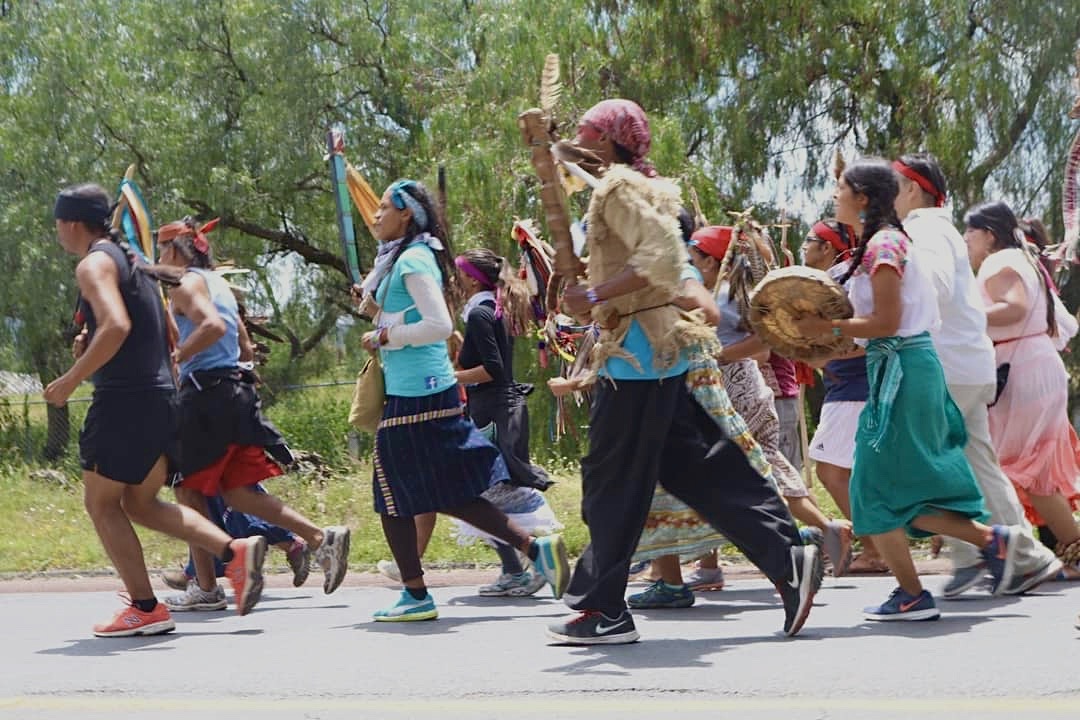
Kasike and other runners entering Teotihuacan (Mexico) during the Peace and Dignity Journeys, 2016. [Photo: Vanessa Quezada]
What has been your experience with the Peace and Dignity Journeys?
In 2016, I ran the prayer staff for the entire Caribbean region, representing all the Taino people and First Nations of the Caribbean. That prayer run was from New York to Panama, connecting with other tribes and indigenous groups. I remember when I went to Guatemala and Panama, and my Spanish is not great but I remember saying that I’m from Jamaica and the response was, Oh, Taino! I was amazed because that’s not how anyone from Jamaica openly identifies oneself. So to be called that so easily in a foreign land was a wake up call in Spirit. Confirmation that the work that we are doing is reconnecting these pathways, these trade routes.
On my return to the island, the ancestors asked me to create a space for the Taino descendants of this island, and the Maroons who want to learn about their Taino ancestry because the Watiao ceremony was done, which is the ceremony of brotherhood, of connection, of unity, so the Maroons are Indigenous to this land through that connection. The keepers of those mountain spaces, of those rainforests. And I’ve been working with Spirit to strengthen connections with other descendants here locally. And my edict now is to preserve our songs, preserve our language, preserve our culture, preserve our ways. And what we don’t have on the island, we learn from our other relatives throughout the diaspora.
Many today in the Native American community have a problem with identifying as both Indigenous and Black. We do not. We honor all that our ancestors did from 1492 to present.
What does the Jamaican Hummingbird Tribe bring to the wider conversation and ecosystem of Indigenous peoples in the Americas?
As it relates to the Taino community, the focus has always been on the Spanish-speaking islands, so many assume we in Jamaica had no retention or didn’t exist. Speaking up now, we have maintained sacred sites, teachings and some ceremonies. We have our unique identity that didn’t die in 1494 when Columbus came or in 1655 when the British came. It continued to evolve. The hummingbird, also called the doctor bird, is the healer and messenger. I believe we can be an example of how to honor all our ancestors to present and not erase those that fought for us to be here during the five hundred years of slavery. Many today in the Native American community have a problem with identifying as both Indigenous and Black. We do not. We honor all that our ancestors did from 1492 to present. We are not trying to re-create what our ancestors did prior to 1492 as we have ancestors that were walking among the living up to last year. We honor them all. With the colonizer coming to this side of the world, the Tainos were the first to be impacted, way before Plymouth Rock. We have prophecies that speak that things will come together when our people, the Taino, who were the first to be impacted, are again in the circle, are again part of the fold. And that is taking place now.
Race aside, how does Taino culture align with, or diverge from, other Native groups throughout the Americas?
The cultural identification of Tainos aligns with other Native American groups because we have similar practices, more so with South American Natives than North American Natives. We all honor nature, we all value our ancestral stories as valued teachings on life values and we all believe in rites of passage as the method to find our place in the larger society. We all honor our ancestors and try to make them proud in our daily life. The differences between us and some of the northern tribes is that we are matriarchal and our supreme deity is feminine. Our tribe specifically is matrilineal – your connection to your indigeneity is through your mother’s line. These things greatly influence our view on the role of women and children in society.

Bohito (elder) Ciba Inaru, pictured on the left, places Kasike’s cachucha (headdress) on his head during his investiture ceremony. She is assisted by Ata Bibi (grandmother) Karaira. [Photo: Paul Williams]
What are some of women’s roles?
The leaders are chosen by the women. For the first seven years of life the child is taught by the mother, whether the child is male or female, for the women pass on the culture. The women know all the medicinal herbs and are very integral to the preservation of these teachings and practices. They are the life force of our people and the men’s role is to protect them.
Are there any misconceptions out there affecting Indigenous people?
There are Black movements out there claiming to be Aboriginal Americans, stating that the original natives of America were Black – in this context they mean negroid and carrying typical negroid phenotype. According to them, Blacks were always in the Americas and the transatlantic slave trade happened in reverse, removing them from the Americas and shipping them to Africa. Whether they are aware of it or not, they are working with the colonizer mindset and trying to claim what belongs to the Native people.
Our focus is to bring back life and honor to our Taino ancestry, to preserve our Native American culture but not at the expense of ignoring the rest of our ancestry.
How do you respond when you hear Black movements insert themselves into the Indigenous narrative of the Americas?
This disrespects the efforts of our Native American and African ancestors, both of whom were enslaved and fought and struggled so that we may have the opportunities we have today, to be reading and writing and traveling as free people. All cultures that survived until and after colonization should be honored and respected. None is superior as these teachings and ways maintained for several hundred years in harmony with the environment. The racist Afrocentric movements today truly resemble a Black face on white supremacy, claiming Black people are the seat of civilization and traveled the world teaching and educating all the other ignorant races. Just as fire was gifted to all races, so too do Indigenous teachings share that certain knowledge comes from the Creator gifting the people what they need to live in harmony. I believe there are good people and bad in every race, family and ethnicity. We must honor the good in all aspects of our ancestry.
I speak as a West Indian, which means that on the island I am considered brown, whereas anywhere else in the world I am a Black man. No true West Indian disowns their European or African ancestry. And I want to clearly state that, yes, I have, as some say, dark brown skin and there are others of my complexion that have Taino ancestry, African ancestry and European ancestry. And none in the Taino community claim to be Aboriginal Americans. We acknowledge our mixture and we do not deny our African ancestry, we do not deny our European ancestry. Our focus is to bring back life and honor to our Taino ancestry, to preserve our Native American culture but not at the expense of ignoring the rest of our ancestry.
Who are people throughout the African Diaspora (past and present) who have shaped or influenced you?
Louise Bennett, Bob Marley, Peter Tosh, Colonel Frank Lumsden, who was the previous chief of the Charles Town Maroons, and my ancestors George Fletcher and Aston Simmonds.
What recent or favorite book(s) would you recommend to readers?
Guns, Germs and Steel by Jared Diamond, Shaman, Healer, Sage by Alberto Villoldo, Black Elk Speaks by John G. Neihardt, Earliest Inhabitants: The Dynamics of the Jamaican Taino by Lesley-Gail Atkinson and The Wretched of the Earth by Frantz Fanon.
If culture is the last stand, what is culture to you?
[Read for context: Culture is the last stand]
Culture is the savior. Culture is what kept the balance between tribes, mankind and animal kind along with all of nature for centuries. It shapes our world view and understanding that we are all Earthlings with different gifts to share for the development of the planet and the human race.
